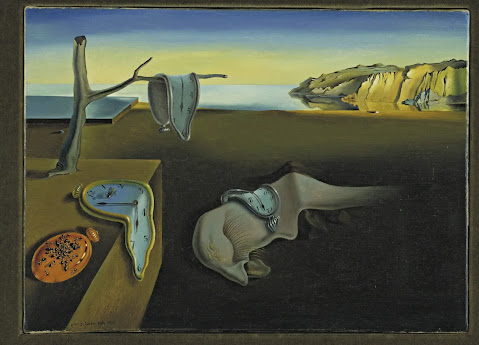Paul's Post 2/5/24 Art analysis
Analysis of The Persistence of Memory (1931) by Salvador Dalí
Overview of "The Persistence of Memory"
"The Persistence of Memory" is one of the most well-known paintings by the Spanish artist Salvador Dalí. This work is characterized by its dreamlike quality which became iconic of Dalí's work as a surrealist (Lewis, 2021). The most obvious element of this work is the presence of melting clocks draped over various objects. The soft, drooping forms suggest a distorted malleable concept of time and challenge the conventional idea of its stability. This surrealist representation likely serves to convey the fluidity and subjectivity of time as it is experienced in a dream state (Streete, 2023). The background features a bare, rocky landscape with cliffs and a distant body of water. The seemingly empty setting contributes to the dreamlike atmosphere and adds to the sense of distortion. Other objects in the painting, such as the seemingly face-like form in the center and the melting tree in the background, contribute to the overall sense of instability and change. These distorted forms emphasize the malleable and subjective nature of reality. Several ants are depicted on the pocket watch in the foreground. This is the only timepiece in the painting that is not completely disfigured like the clocks we see hanging. Dalí was inspired by his observations of how ants can erode and break down substances over time (Streete, 2022). The inclusion of ants adds a sense of decay to the inevitable passage of time as the ants consume the pocket watch like it were a piece of fruit of a similar shape.
Interpretation
The interpretation of "The Persistence of Memory" is subjective, and Dalí himself provided several different explanations when inquired over the years. Many art historians and critics view the painting as a reflection on the relativity of time, and the fluidity of memory, with an emphasis on the subconscious mind. The distorted clocks and other forms suggest that time can be elusive and ever-changing. Dalí's fascination with the concept of "paranoia-criticism," where an artist intentionally distorts reality to evoke psychological responses, is evident in this painting (Tate, 2023). Regardless of interpretation, this work remains a captivating and enigmatic piece that invites viewers to explore the boundaries of perception, time, and memory in an introspective way.
Lewis, Emma. “Surrealism.” International Symposium on Medical Simulation, 2021, https://doi.org10.2307/j.ctt18fs791.6.
Streete, Wallis May. “The Persistence of Memory: Exploring Salvador Dali’s Greatest Masterpiece.” Medium, 11 July 2023, https://wallismay-streete.medium.com/the-persistence-of-memory-exploring-salvador-dalis-greatest-masterpiece-7ad47c3ff243.
Tate. “Surrealism.” Tate, https://www.tate.org.uk/art/art-terms/s/surrealism.6 Feb. 2023.



Comments
Post a Comment